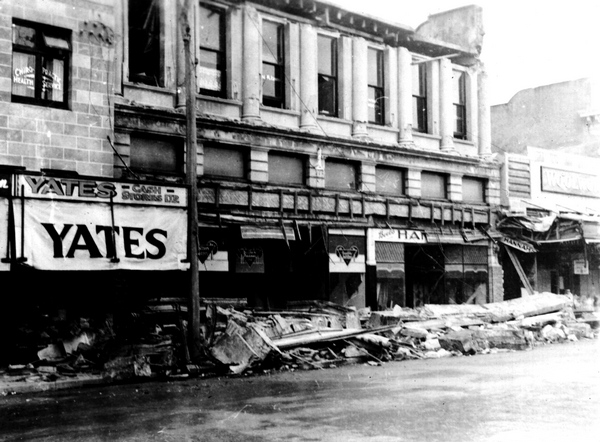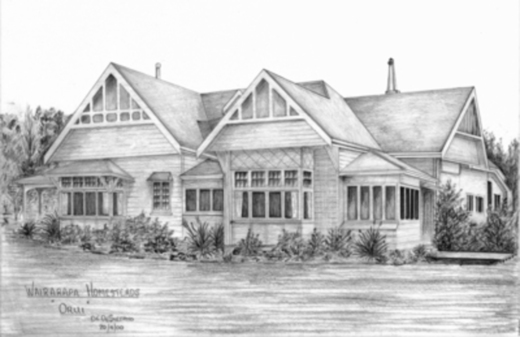1942 Earthquake: Masterton's business area badly wrecked
Evening Post, 26 June 1942
"MILITARY TAKE OVER CONTROL
Masterton's main street was a sorry sight yesterday.
With huge piles of brick and masonry sprawling across the footpaths and roadway, shattered shop windows, and trailing high-tension lines, the condition of the mile-long thoroughfare was testimony to the intensity of the previous night's earthquake. In the residential areas householders suffered considerable damage to property, and it appears that Masterton took the main shock. Miraculously no casualties of any sort have been reported.
 |
Damaged buildings in Queen Street, including Yates
Cash Store and Hannah's shoe shop. There is rubble from collapsed facades
lying in gutter. The Gray Brothers building has lost the verandah.
02-86/6
02-86/6
It will be years before Masterton is fully restored, but in the midst of all the destruction the Masterton people are devoutly thankful that the 'quake happened when it did. Had the shake occurred during business hours nothing could have averted a repetition of the Napier tragedy.
There is a trail of damage from Featherston onward right through the Wairarapa with climax of devastation at Masterton.
There is no disruption of road traffic, though a detour has to be made at Greytown because of damage to the Waiohine Bridge, the approaches to which have cracked and sunk at either end.
Immediate steps were taken by the Mayor of Masterton (Mr. T. Jordan) to declare a state of emergency in the town. The business area was roped off and guarded by military pickets, and no one except people on official business was allowed in the isolated area. Even then strict instructions were to walk in the centre of the roadway.
Demolition squads supplied by the military authorities were quickly on the job, and they worked through yesterday, frequently in a cold, southerly drizzle that emphasised the general air of desolation.
 |
| Earthquake damage to J.V. Gordon's Chemist Shop, in the T. G. Mason Building, on the corner of Bannister and Queen Streets, Masterton. |
Shopkeepers surveyed their ruined premises, and reflected ruefully on the losses they had sustained, particularly in the way of stock that is hard to replace. The scenes in some of the grocery shops were indescribable. The floors were covered with the contents of bottles dashed from shelves, and of packages burst open in falling.
In the chemists' shops and other premises where bottles were used largely as containers the mess was terrible.
One grocer who was digging out the sticky mixture on his shop floor with a shovel had a courageous philosophy that had to be admired. Stocks of goods of all kinds were in a tangled mess all over the shop, and as he sorted out the wreckage he remarked: "This is going to cost me hundreds of pounds — no insurance— but what's the good of moaning about it? Bad luck, that's all."
EXTENT OF DAMAGE
It is difficult to estimate the damage done to property alone in the main street, but it will run into many thousands of pounds.
The superficial damage visible in a tour of the area is only a small part of the total destruction, and even then it is awesome enough. The whole front of one big shop, Bullick and Blackmore's, tumbled into the street, piling tons of cement and brick almost across the road.
On the opposite side the whole front of one shop was cut away as if with a knife, exposing the two living-rooms upstairs. In one of them stood a piano.
 |
| Cleaning up after the earthquake, Queen Street, Masterton, in front of Bullick and Blackmore, Hannah's and Woolworths |
The verandah of a chemist's shop on the corner of Perry Street and the main street collapsed on the path, with piles of brick and rubble on top of it. A tower on this building was ready to crumble without warning, and sappers got busy on it and demolished it before it did.
 |
| Interior of Woolworths, Masterton. |
St. Matthew's Anglican Church looks as if it bad been bombed. The eastern wall has been shattered and the organ and stained glass windows wrecked, and the whole structure looks to be beyond repair. The chancel collapsed completely.
The front gable of the Presbyterian Church on the main street was torn away, and crashed through the entrance vestibule, and in St. Bride's Convent a falling chimney damaged the altar in the chapel.
WATER TOWER FOLDS UP
 |
| Collapsed water tower, W.F.C.A building |
Spectacular damage was done when the 40,000-gallon water tower at the rear of the W.F.C.A. building folded up into a pile of concrete and brick and splintered timbers; while three cars were damaged when the top section of the Midland garage tumbled down.
The large brick post office was badly strained, and in places masonry was dislodged. In case of further falls the main part of the building was closed and roped off, and emergency quarters were established in the rear of the building.
The municipal gasworks was badly damaged. The 50ft chimney stack came down with a roar, and huge sections of the engine building were shaken to the ground.
Here and there falling masonry penetrated roofs and wrecked shop interiors. Woolworths shop suffered when the adjoining wall crashed through the roof, and in Hugo and Shearer's millinery room lay a heap of bricks that had torn a hole in the roof.
In a number of buildings large gaps have been left where has been jerked loose, and many are badly cracked. Among these are the Empire Hotel, the Prince of Wales Hotel, the Fire Brigade building, from which the engines have been removed for safety, Dalgety's building, and the Bank of New Zealand. Dozens of others are structurally damaged in lesser degree. Many of the older buildings will have to come down.
It was noticeable that modern concrete structures suffered a minimum of damage.
A NOTABLE ESCAPE.
 |
| Post Office tower being demolished. While it survived the June 1942 earthquake, it was subsequently discovered to be damaged and was removed. |
A notable escape from damage was the Post Office tower, which stood a severe test. It proved the effectiveness of the strengthening which was carried out after the heavy earthquake on March 5,1934, which caused damage in Masterton amounting to almost £25.000. [see photo caption above]
A number of chimneys fell at the Masterton Hospital, but no one was injured. It is stated that two bricks fell alongside a three-hours-old baby, which was uninjured.
The Prime Minister communicated with the Mayor, stating that he would be pleased to give every assistance possible.
Public Works Department engineers are visiting Masterton to confer with local body representatives in order to ascertain the needs of the situation.
The Mayor asked that all bricklayers in camp should be released to assist in rebuilding chimneys."
Source: Papers Past - Evening Post, 26 June 1942
Further reading: A night of terror - the 1942 earthquake

Comments
Post a Comment